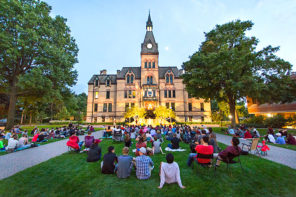What inspired you to write Islamophobia and Racism in America?
The work that became this book really began for me in the year 2000. That year, I went on an off-campus study program in Jerusalem. Thanks to this innovative program, I took classes with professors from both sides of the Green Line. I came to realize that even though I had studied race and ethnicity for more than four years in college and high school, I had never read a single academic document on Arab or Muslim Americans. That struck me as odd. I was curious about the history of these communities, and even more curious as to why it seemed so little attention had been paid to them in the mainstream of research on race and racism in America.

Islamophobia and Racism in America
Erik Love
NYU Press
May 2017
My mentor, Professor Leonard Berkey, directed me toward the foundational research by scholars like Yvonne Haddad, Alixa Naff, Nadine Naber, and Michael Suleiman. I found myself fascinated by the relationship between Arab, Muslim, and broader Middle Eastern heritages and ethnicities with socially constructed racial categories in America. Where and how did these communities fit in? It was a puzzle I couldn’t solve—one that I still cannot figure out.
Years later, in graduate school and under the expert direction of my advisor, Professor Howard Winant, I developed a focus on advocacy organizations. The idea was to examine the ways that advocates came to understand this puzzle: how do you deal with the issue of race in America if you’re a Middle Eastern American civil rights advocate? That is the central question I wrestle with in my book.
What’s the most important take-home message for readers?
The civil rights protections that most Americans believe have great strength to remedy racism have, in fact, been rendered quite weak and ineffective. It has been extraordinarily difficult for civil rights advocates to even make the simple point that Arab, Muslim, Sikh, and South Asian Americans should not face discrimination.
Even as advocates have tirelessly worked to push back against Islamophobia, they have witnessed the constant expansion of deeply harmful anti-immigrant policies and practices, mainly through so-called national security programs. The laws and systems set up in the 1960s to protect communities from racism have not been nearly adequate to protect Middle Eastern Americans smeared with the “terrorist” stereotype.
“The biggest misconception about Islamophobia is that it affects Muslims exclusively.”
Is there anything you had to leave out?
I wanted to look more closely at Arab American civil rights activism in the 1980s and earlier. Fortunately, several excellent books (like Pamela E. Pennock’s The Rise of the Arab American Left) provide in-depth discussions of this history. I also devoted far too little attention to the relationships between primarily “immigrant Muslim” advocates and African-American and other “native Muslim” advocacy efforts.
What are some of the biggest misconceptions about your topic?
The biggest misconception about Islamophobia is that it affects Muslims exclusively. This stems from the term “Islamophobia,” which makes it sound like the source of the problem is an irrational fear of the religion. Of course, Muslims (and Islam—the religion—itself) have faced the brunt of Islamophobia in recent decades. Religion is indeed at the very heart of the problem.
But it is not only religion and “mistaken identity” that makes Arab, Sikh, and South Asian Americans (many non-Muslims among them) vulnerable. Only race can explain this. Because of race—a socially constructed identity based partly on physical appearance—Muslims are not the only communities directly impacted by Islamophobia. My goal with this book was to better understand this disturbing reality while exploring how civil rights advocates deal with racism in the twenty-first century.
Did you have a specific audience in mind when writing?
My greatest hope is that the civil rights advocates that so generously gave of their time to meet with me for interviews will somehow find this book useful. As I wrote each chapter, I sensed these advocates looking over my shoulder, critiquing my analysis. I tried my best to get all the nuanced facts right, while making the book accessible to a broader audience of interested people from outside Middle Eastern American advocacy organizations as well.
Are you hoping to just inform readers? Entertain them? Piss them off?
For anyone willing to read this rather depressing book, my intention is to show them the truth, no matter how unpleasant. I tried my best to deliver the truth as it was told to me by the dozens of advocates I spoke with, and as I saw it in the archival record. If I am even partially successful, then anyone who reads the book will want to learn more about what these remarkable advocates are doing. I hope some will get inspired to become more personally involved in the struggle against Islamophobia.
What alternative title would you give the book?
I had a lot of trouble coming up with a title. I wanted the term “civil rights” in it. For a while, I asked some colleagues if the title The End of Civil Rights: Islamophobia and Racism in America was over-the-top. Most agreed that it was.
How do you feel about the cover?
It’s the best part of the book, and aside from the author’s name at the bottom, I had nothing at all to do with it! Seriously, though, I think the cover is amazing. I have seen people’s eyes pop when they see it for the first time. I am deeply grateful to Adam B. Bohannon and the design team at NYU Press.
Is there a book out there you wish you had written? Which one? Why?
Deepa Iyer’s We Too Sing America is the most important book on this topic. It has all the detail and rigor of an in-depth academic analysis while speaking directly to every single American about the crisis of Islamophobia. Deepa is one of the most important civil rights leaders in the world today, and her work has been an inspiration to me and many others. I can’t tell you how honored I am that she recommended my book in a review.
What’s your next book?
I’m continuing to track the troubling developments around Islamophobia, but I don’t plan to write a second book on this topic. I’ve recently started a new project that once again has me interviewing advocates. As before, I’m asking them about how they deal with an issue deeply affected by race and racism: public transportation in American cities. I want to understand how pro-transit advocates navigate racial politics as they work toward improving access to transportation. It goes without saying that racism plays a major role in the development of transportation systems in the U.S. As with my project on Islamophobia, I want to understand the strategies that advocates are using to confront a race-based problem today in the so-called post-civil rights era.





